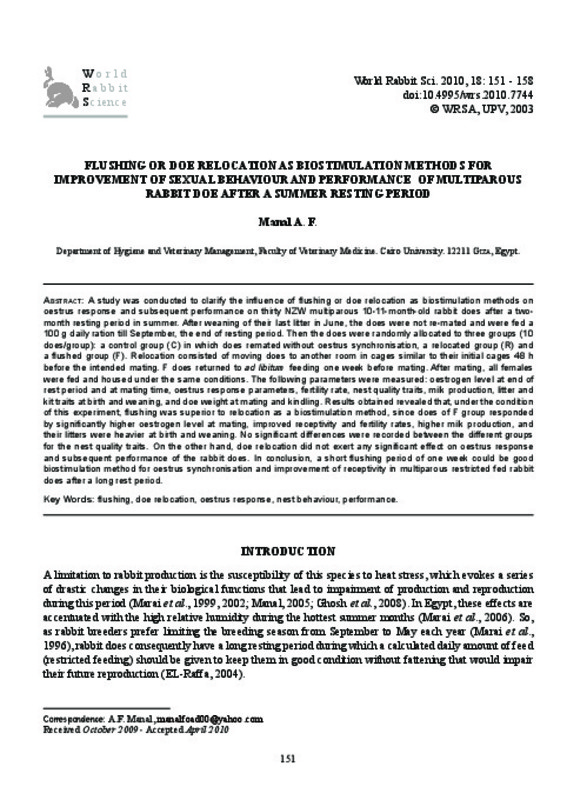JavaScript is disabled for your browser. Some features of this site may not work without it.
Buscar en RiuNet
Listar
Mi cuenta
Estadísticas
Ayuda RiuNet
Admin. UPV
Flushing or doe relocation as biostimulation methods for improvement of sexual behaviour and performance of multiparous rabbit doe after a summer resting period
Mostrar el registro sencillo del ítem
Ficheros en el ítem
| dc.contributor.author | Manal, A. F.
|
|
| dc.date.accessioned | 2010-11-17T09:51:36Z | |
| dc.date.available | 2012-10-17T20:00:23Z | |
| dc.date.issued | 2010-10 | |
| dc.identifier.issn | 1257-5011 | |
| dc.identifier.uri | http://hdl.handle.net/10251/8946 | |
| dc.description.abstract | [EN] A study was conducted to clarify the influence of flushing or doe relocation as biostimulation methods on oestrus response and subsequent performance on thirty NZW multiparous 10-11-month-old rabbit does after a two-month resting period in summer. After weaning of their last litter in June, the does were not re-mated and were fed a 100 g daily ration till September, the end of resting period. Then the does were randomly allocated to three groups (10 does/group): a control group (C) in which does remated without oestrus synchronisation, a relocated group (R) and a flushed group (F). Relocation consisted of moving does to another room in cages similar to their initial cages 48 h before the intended mating. F does returned to ad libitum feeding one week before mating. After mating, all females were fed and housed under the same conditions. The following parameters were measured: oestrogen level at end of rest period and at mating time, oestrus response parameters, fertility rate, nest quality traits, milk production, litter and kit traits at birth and weaning, and doe weight at mating and kindling. Results obtained revealed that, under the condition of this experiment, flushing was superior to relocation as a biostimulation method, since does of F group responded by significantly higher oestrogen level at mating, improved receptivity and fertility rates, higher milk production, and their litters were heavier at birth and weaning. No significant differences were recorded between the different groups for the nest quality traits. On the other hand, doe relocation did not exert any significant effect on oestrus response and subsequent performance of the rabbit does. In conclusion, a short flushing period of one week could be good biostimulation method for oestrus synchronisation and improvement of receptivity in multiparous restricted fed rabbit does after a long rest period. | es_ES |
| dc.language | Inglés | es_ES |
| dc.publisher | World Rabbit Science. ICTA. UPV | es_ES |
| dc.relation.ispartof | World Rabbit Science | |
| dc.rights | Reserva de todos los derechos | es_ES |
| dc.subject | Flushing | es_ES |
| dc.subject | Doe relocation | es_ES |
| dc.subject | Oestrus response | es_ES |
| dc.subject | Nest behaviour | es_ES |
| dc.subject | Performance | es_ES |
| dc.title | Flushing or doe relocation as biostimulation methods for improvement of sexual behaviour and performance of multiparous rabbit doe after a summer resting period | es_ES |
| dc.type | Artículo | es_ES |
| dc.identifier.doi | 10.4995/wrs.2010.7744 | en_EN |
| dc.rights.accessRights | Abierto | es_ES |
| dc.description.bibliographicCitation | Manal, AF. (2010). Flushing or doe relocation as biostimulation methods for improvement of sexual behaviour and performance of multiparous rabbit doe after a summer resting period. World Rabbit Science. 18(3). https://doi.org/10.4995/wrs.2010.7744 | es_ES |
| dc.relation.publisherversion | https://doi.org/10.4995/wrs.2010.7744 | |
| dc.description.volume | 18 | |
| dc.description.issue | 3 | |
| dc.identifier.eissn | 1989-8886 | es_ES |








